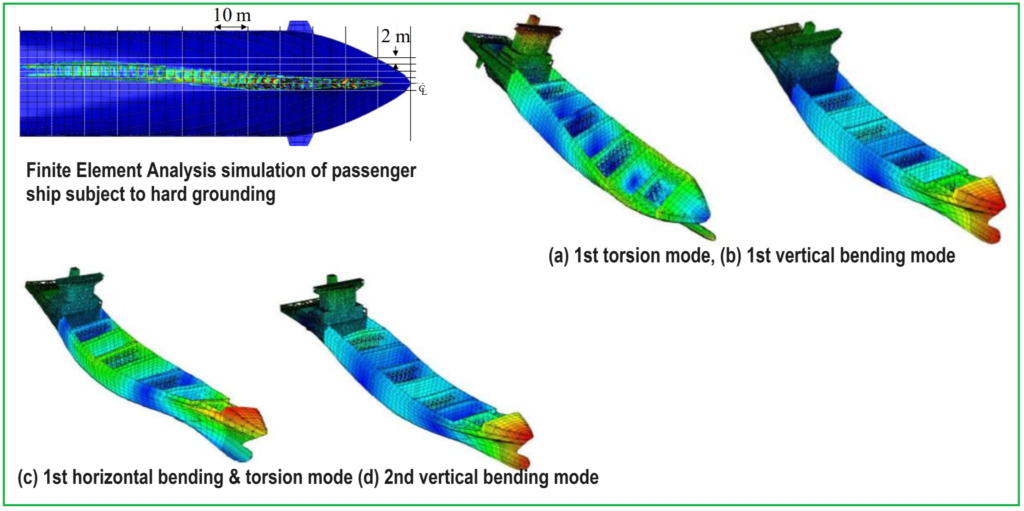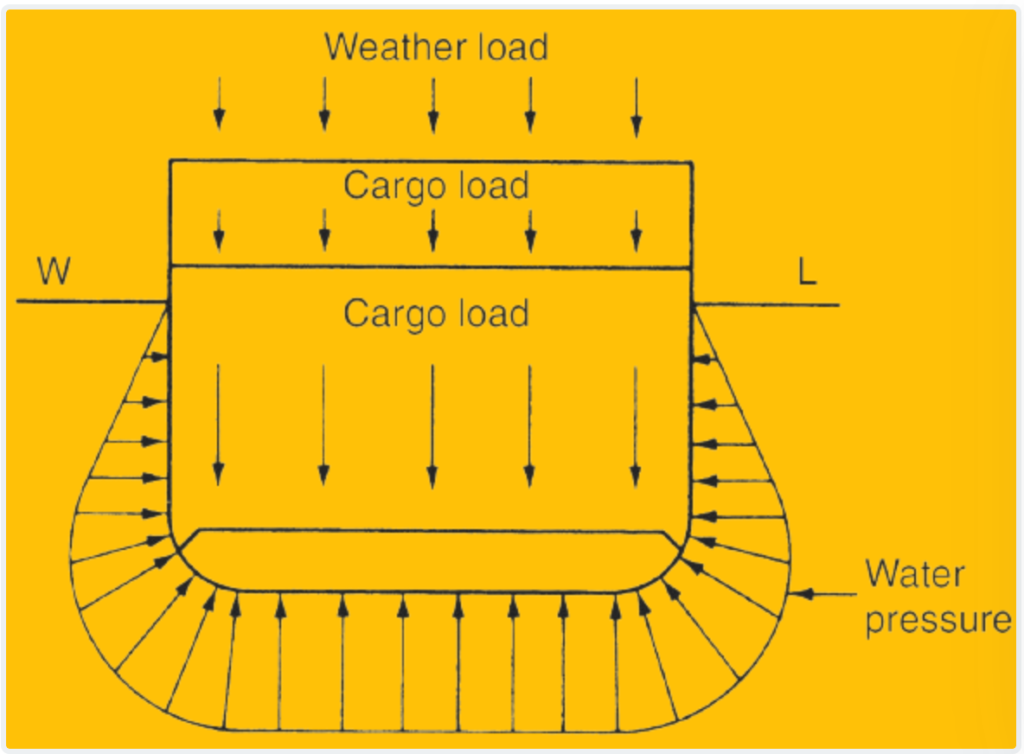Ship loads refer to the various forces and stresses that act upon a ship’s structure and components during its operation. These loads can arise from a variety of sources and can affect different parts of the ship in different ways.
Ship Loads
The background of ship loads, as outlined by Hirdaris et al. (2018), provides a comprehensive taxonomy based on various factors such as frequency, time duration, locality, and limit states. Here’s a breakdown of their classification:
- Static Loads: These loads act on a ship in still water or during loading/unloading operations. They typically vary over longer time periods and are considered as a function of the ship’s loading conditions.
- Quasi-Static Loads: These loads have periods corresponding to wave actions (typically between 3-15 seconds). They are induced directly by waves and resonate with the ship’s motions.
- Dynamic Loads: These loads result in responses with frequency components close to or equal to resonance modes. They may be generated by resonance phenomena associated with wave-induced hull vibratory distortions (e.g., springing) or by mechanical excitation of rotating equipment like the main engine and propeller.
- Impulsive Loads: These loads result in free structural vibrations, such as slamming and sloshing in tanks. They can have significant effects on the ship’s structural integrity and must be considered in design and analysis.
- High-Frequency Loads: These loads have frequencies higher than resonance modes (typically above 10-20 Hz). They are primarily associated with noise studies rather than structural design.
- Global Loads: These loads act on the ship as a whole, treating it as a girder or box beam. They include primary level loads and are associated with the ship’s primary response.
Local loads on the hull
Local loads on the hull due to wave actions can have significant impacts on ship structures. Some examples of these local loads include:
- Panting: This refers to the in/out motion of the plating in the bow area of the ship due to unequal pressure through waves. It is particularly significant for ships with fine bows. Fore peak tanks are often utilized to resist this load and minimize its effects on the hull structure.
- Bow Slamming: Bow slamming occurs when the bow of the ship experiences sudden lifts and drops in waves, particularly at the forefoot. This phenomenon is closely related to heave and pitch ship motions and can result in high acceleration forces on the hull structure.
- Whipping: Whipping is a transient structural response of the ship to impulsive loading, typically caused by slamming or the impact of green water on the hull. It involves dynamic bending and flexing of the hull structure, which can lead to localized stresses and fatigue damage if not properly mitigated.
Understanding and mitigating these local loads is crucial for ensuring the structural integrity and safety of the ship, especially during challenging sea conditions. Design features and structural reinforcements are often implemented to reduce the effects of panting, bow slamming, and whipping on the hull and associated components.
Global loads on a ship
Global loads on a ship encompass a variety of forces and pressures that act on the entire hull structure. Here are some examples of global loads:
- Hydrostatic Pressure: This is caused by the static pressure exerted by water on the submerged hull of the ship. It is proportional to the depth of submersion and is essential for maintaining the ship’s buoyancy and stability.
- Racking: Racking occurs due to ship rolling and accelerations, causing torsional forces and deformations in the ship’s structure. It is important to ensure that the ship’s structural integrity is maintained under these dynamic loading conditions.
- Still Water and Wave Bending Moments: These moments result from the uneven distribution of buoyancy and weight along the length of the ship. They induce bending stresses in the hull structure and must be carefully considered in the design to prevent excessive deflection and structural failure.
- Shear Forces: Shear forces act on each section of the ship’s hull and are caused by the distribution of hydrostatic pressure and other external forces. They contribute to the overall structural loading and deformation of the ship.
- Springing: Springing refers to the resonant vibration of the ship’s hull in response to wave action. It can lead to fatigue damage and structural failure if not properly addressed in the design.

Accidental loads, on the other hand, are low probability events such as collisions, groundings, or explosions. These events can have severe consequences for the ship’s structural integrity and safety and are typically not accounted for in classification rules or procedures. However, studies are ongoing to better understand the mechanics of such events and develop guidelines for predicting and mitigating their effects on ship structures.
In ship design, these loads are expressed in terms of bending moments, shear forces, and associated stresses to ensure that the structural components can withstand the expected loading conditions throughout the ship’s operational life.
Still Water Loads
The force tending to shear the structure along its length, often referred to as the shear force, can be defined by integrating the net loading along the length of the hull. Mathematically, this can be expressed as:
Shear Force per unit length=∫(pga−mg)dx
Where:
- ( p ) is the density of the water where the ship operates,
- ( g ) is the gravitational acceleration,
- ( a ) is the immersed cross-sectional area of the hull at a given point,
- ( m ) is the mass per unit length of the ship,
- ( dx ) represents an infinitesimal length element along the hull.
This integral expression accounts for the difference between the buoyancy per unit length and the weight per unit length of the ship, resulting in the net force acting along the length of the hull. This net force can induce shear stresses within the structure, which must be considered in the design to ensure the structural integrity and stability of the ship.
The integration being from one end to the point concerned. Integrating a second time gives:

The calculation of the ship’s draft at various loading conditions involves determining the weight distribution and buoyancy distribution, which are influenced by the ship’s geometry and the surrounding water. By analyzing Bonjean curves, which depict the distribution of buoyancy for different draft levels, the net load per unit length can be determined.
When the ship is subjected to static forces such as weight and buoyancy, these forces act upon the transverse section of the ship, leading to transverse distortion of the structure. This distortion must be resisted by the structure’s strength. Additionally, hydrostatic loads can cause local deformations, such as dishing of plating between supporting frames and longitudinals.
To support the loads of equipment and cargo, the deck grillages play a crucial role. Therefore, different components of the ship’s structure contribute to its overall strength, including longitudinal, transverse, and local strength. In the assessment of a ship’s structural integrity in rough seas, longitudinal strength is often prioritized.
